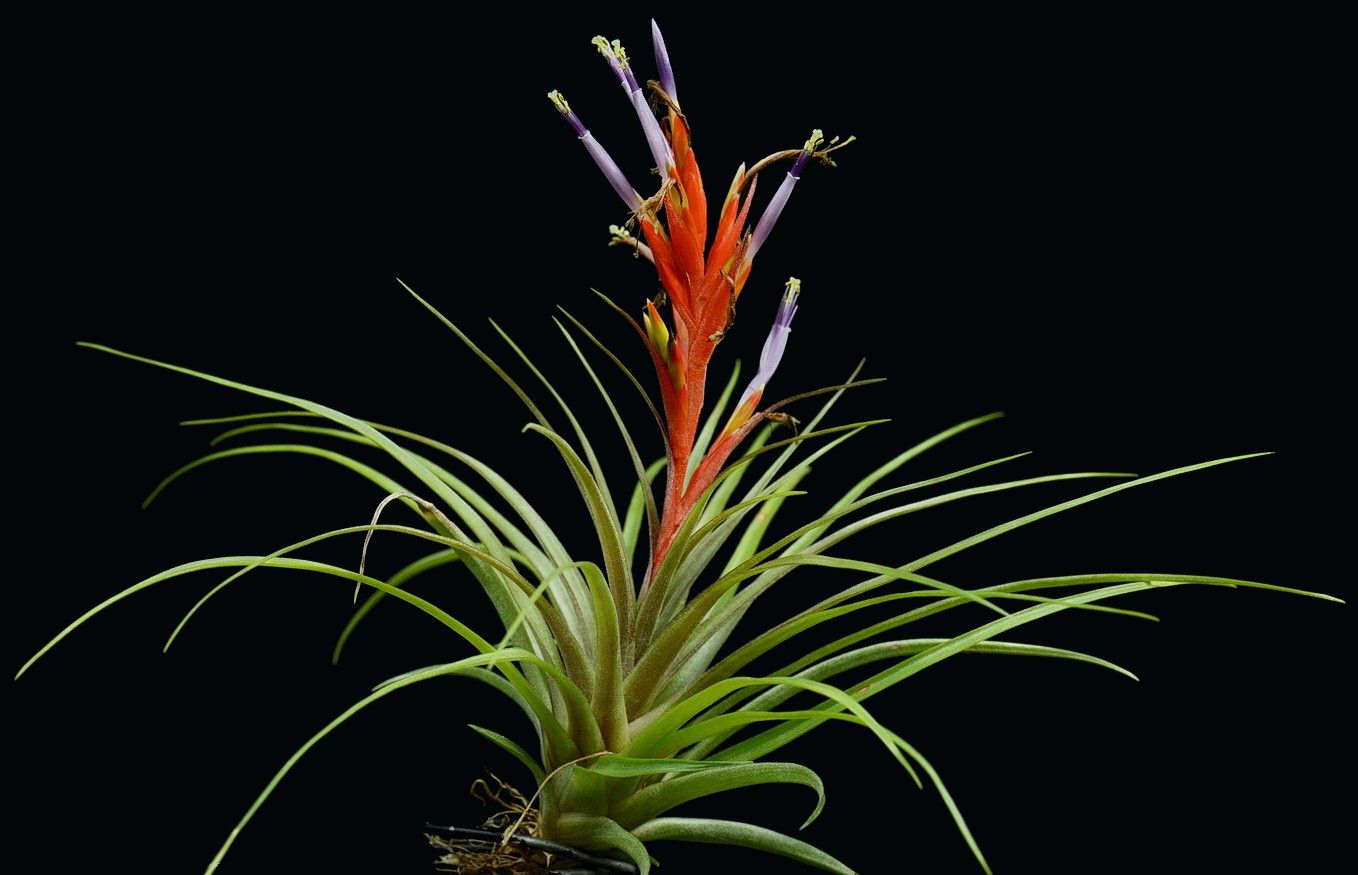
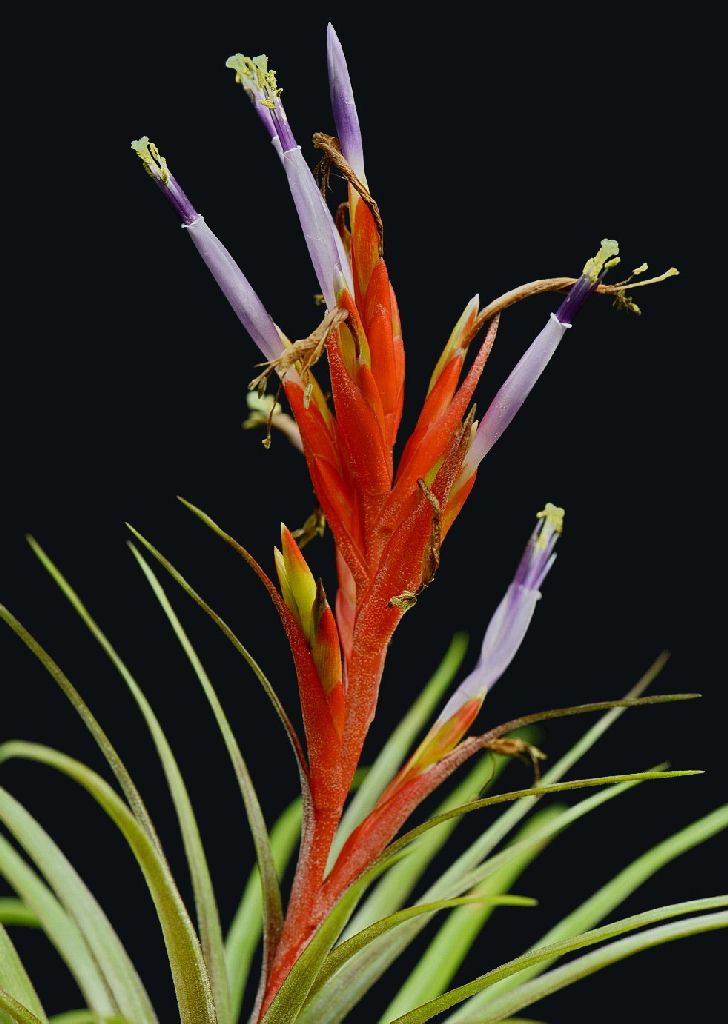

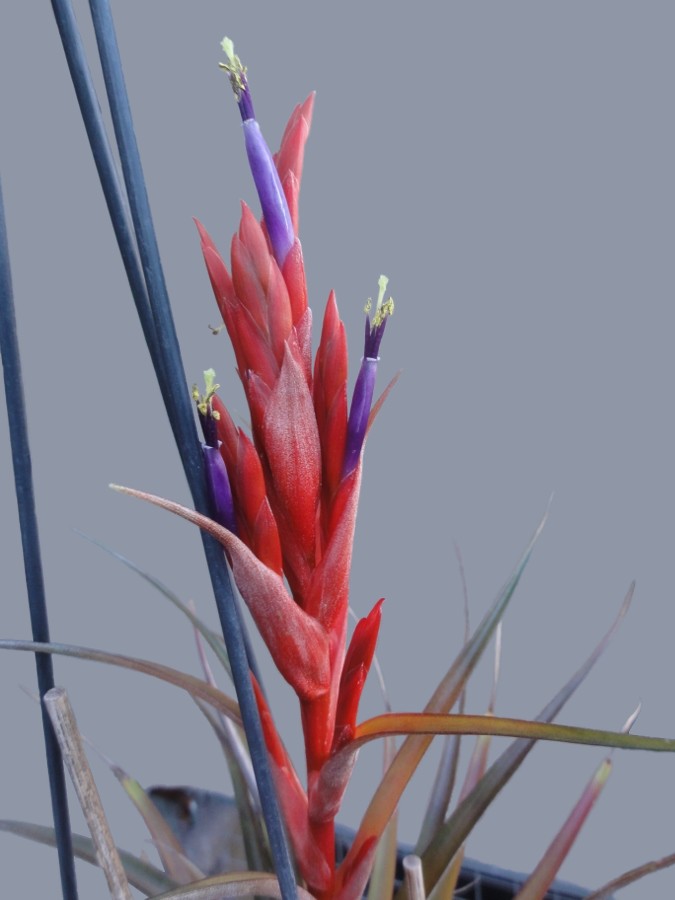
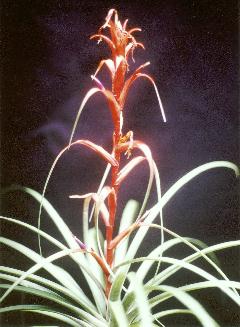
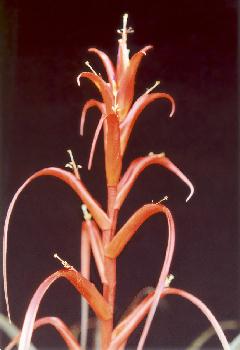
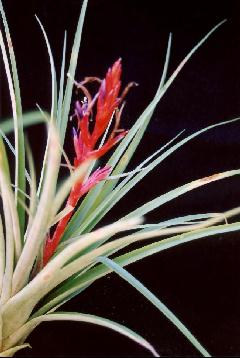
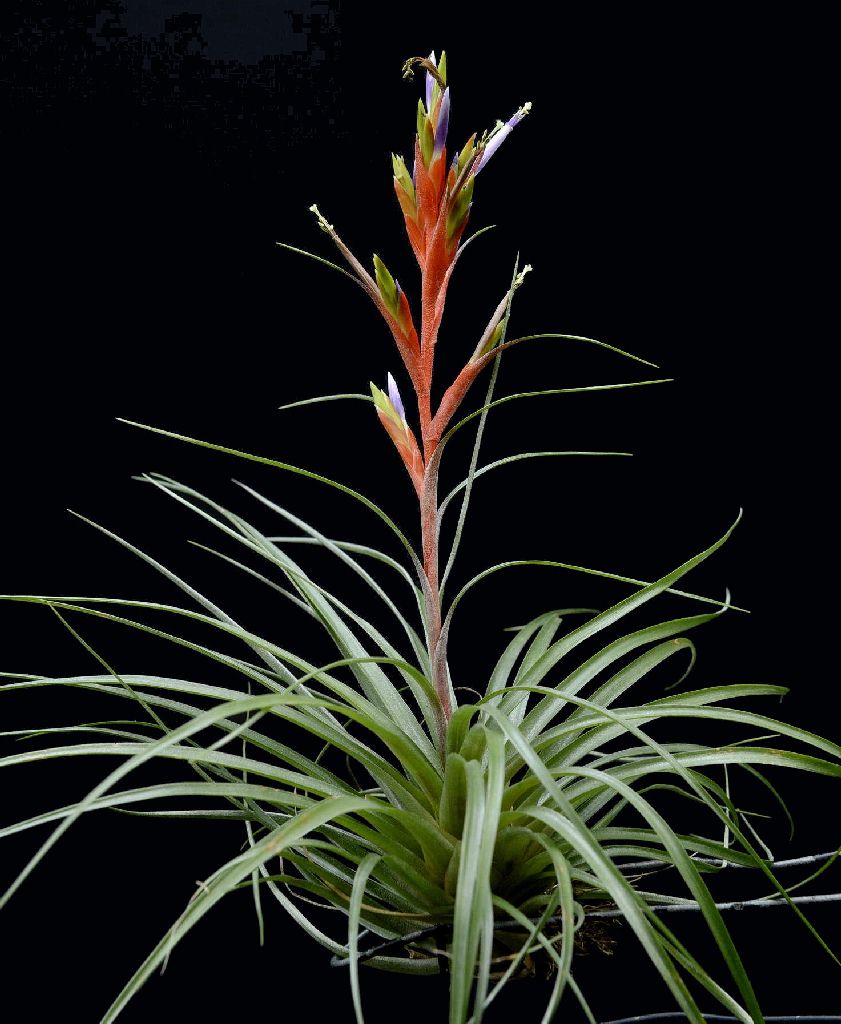
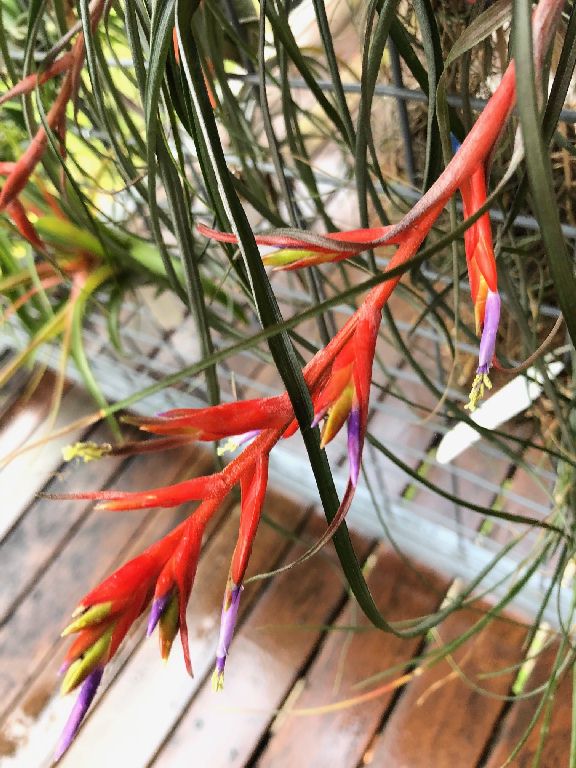
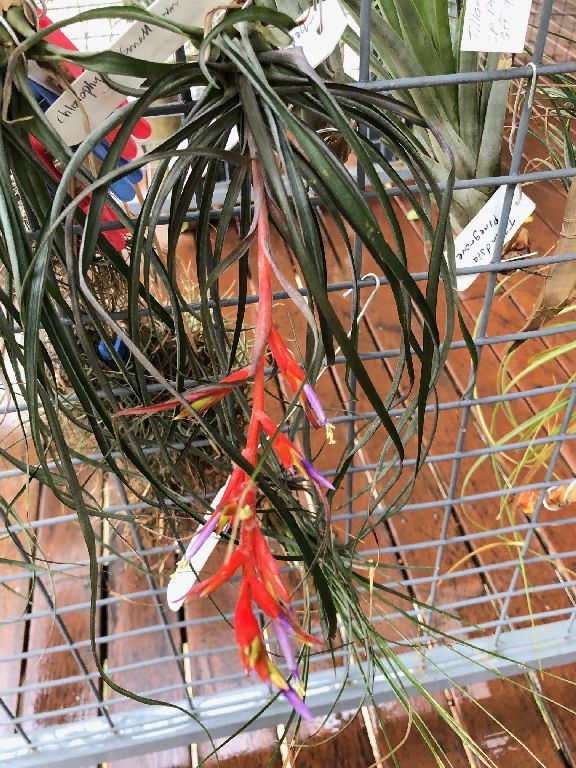
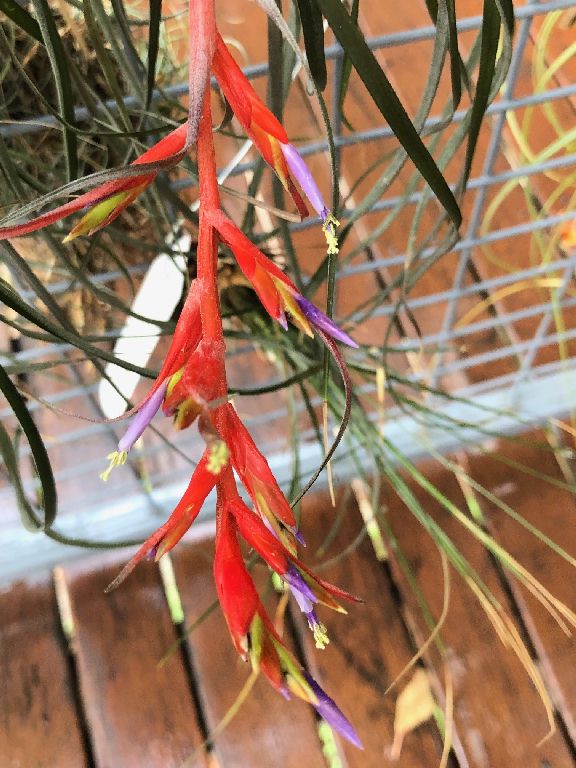
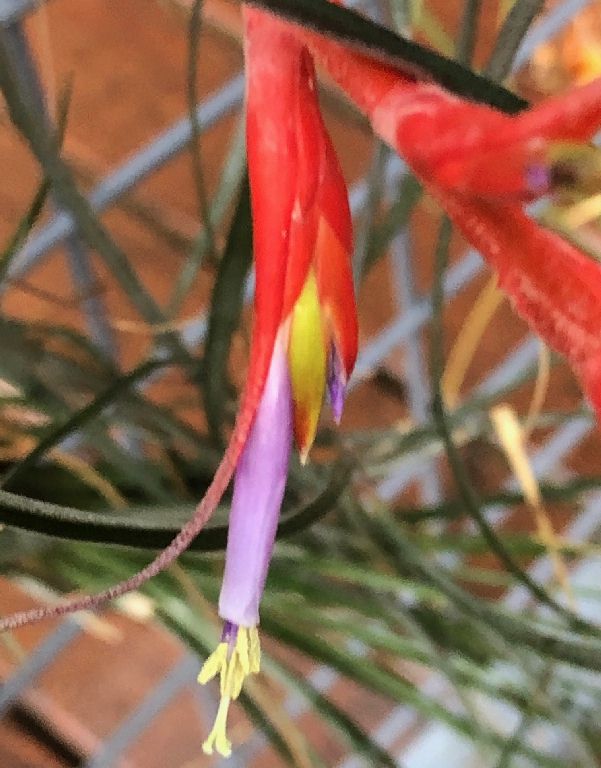
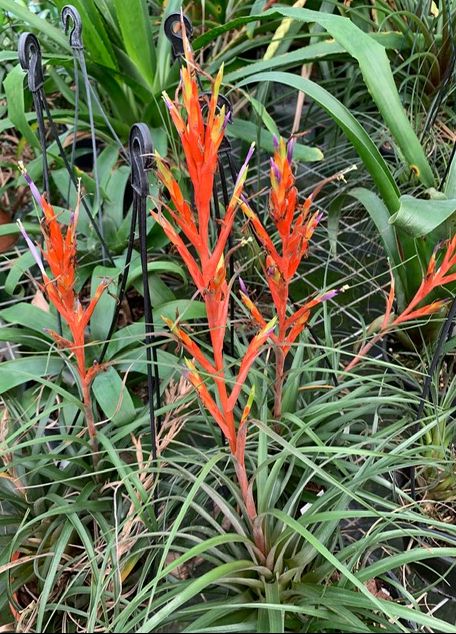
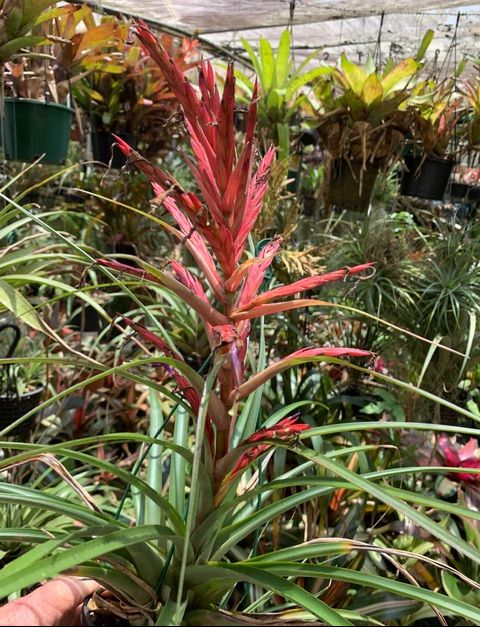
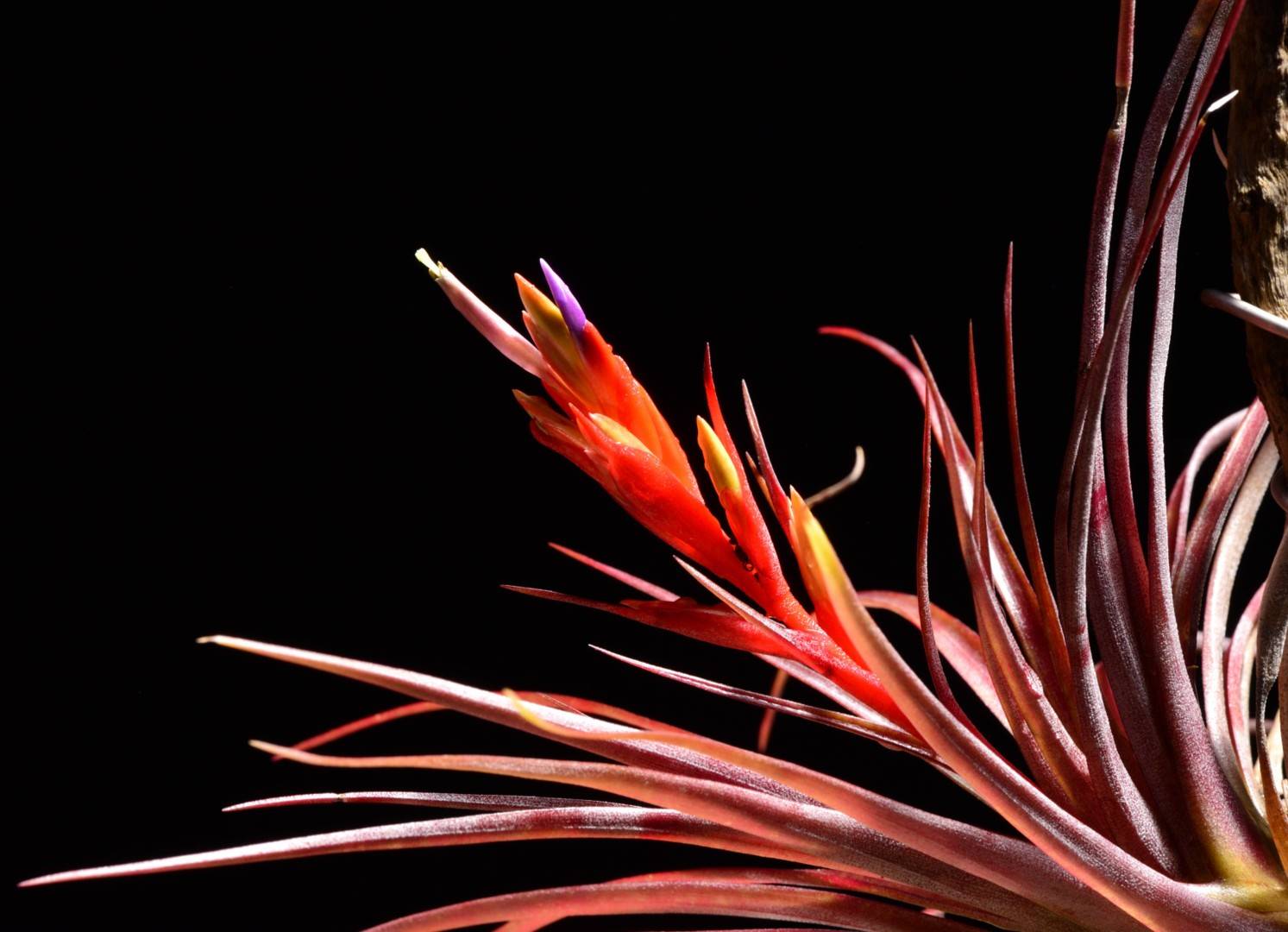
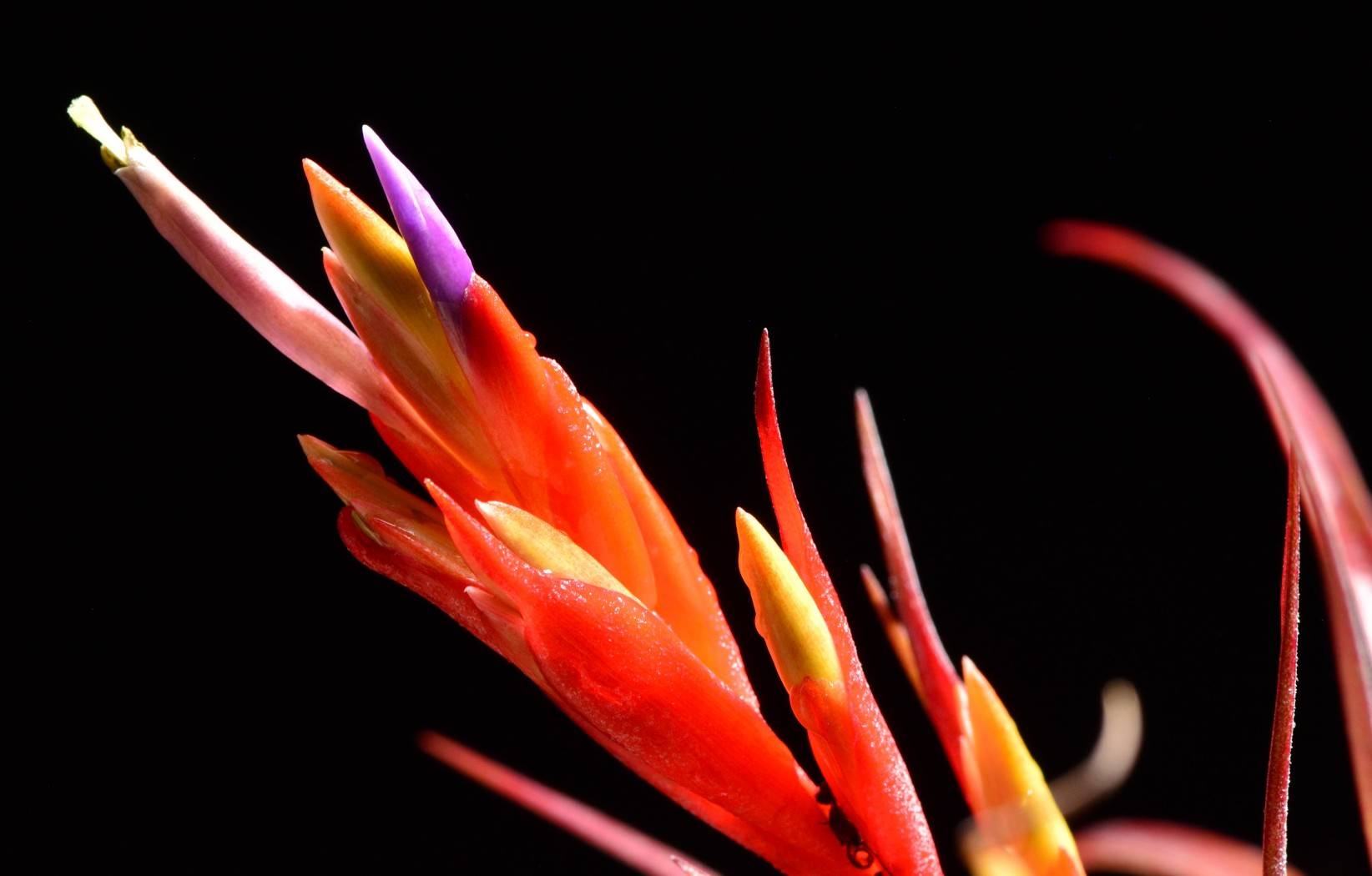
Descr from S&D p962-3 and Gardner 1982 in brackets
Plant stemless. (Erect, funnel form, impounding, 15 to 30 leaves, offsets freely)
Leaves many in a narrowly crateriform rosette, 5 dm long, greatly exceeding the inflorescence; (25 cm long)
Sheaths ovate-elliptic, 6 cm long, green, scarcely darker than the blades, densely and finely appressed-lepidote; (8 cm long, 47 mm wide, both surfaces light brown, glabrous)
Blades linear-triangular, attenuate, 1 cm wide at the base, flat, densely lepidote beneath, soon glabrous above. (21 mm wide, triangular, thin, both surfaces glabrous.)
Scape erect, slender, largely hidden by the leaves; (Elongated, shorter than leaves)
Scape-bracts erect, densely imbricate, subfoliaceous but with pink sheaths (Imbricate, #32 red.)
Inflorescence sublaxly compound from a few simple branches, slenderly pyramidal, 8-12 cm long; (Erect, pinnate, 5 to 10 branches)
Primary bracts like the upper scape-bracts, shorter than the axillary spikes but the lower ones with elongate blades exceeding them; (Much shorter than branches, #32 red, glabrous.)
Spikes divergent to spreading, lance-oblong, complanate, 3-5 cm long, 7-10 mm wide, 3¨6-flowered. (lanceolate, complanate, spreading to 90 degrees.)
Floral bracts erect, elliptic, obtuse, over twice as long as the internodes, distinctly shorter than the sepals, ecarinate, chartaceous, nerved, glabrous, pink; (deltoid, imbricate, firm, glabrous, abaxial surface polished, #32 red, 11mm long, 7mm wide)
Flowers subsessile.
Sepals elliptic, obtuse, 11 mm long, chartaceous, nerved, glabrous, equally short-connate; (Lanceolate, thin, glabrous, #32 red, 12 mm long, 4 mm wide, posterior sepals carinate and 1/2 connate.)
Petals 25 mm long, purple; (Spatulate, erect, #53 lavender, 40mm long, 7mm wide)
Stamens and pistil exserted. (FILAMENTS #53 lavender, 42 mm and 44mm long, ANTHERS: 2 mm long, attachment 1/3 from base, pollen pale yellow, endothelium black. STYLE 36 mm long, flushed #53 lavender. STIGMA: Green, non-papillose, strict to sub-spreading, not twisted.)
Type. Lundell 2649 (holotype GH, isotype MICH), Monte Santa Teresa, Peten, Guatemala.
DISTRIBUTION. Saxicolous and epiphytic in forest, 150-400 m alt, northeastern Guatemala, British Honduras.
GUATEMALA. PETEN: Rio de la Pasion, Mar 1954, Melhus s n (LL); Rio Quebrada Seca, 11 Jul 1959, Lundell 16370 (LL, US). ALTA VERAPAZ: Finca Volcan, Ixte, 22 Feb 1939, C. L. Wilson 240 (F); Cubilgiiitz, 1 Mar 1942, Steyermark 44430 (F, GH); 44438 (F); Cerro Chinaja, Finca Yalpemech to Sacacao, 5 Apr 1942, Steyermark 45698 (F, GH). IZABAL: Jocolo, 25 Jan 1921, Johnson 1152 (US); Bananera to Montana del Mico, 28 Mar 1940, Steyermark 38155 (F); Izabal, Montana del Mico, 2 Apr 1940, Steyermark 38601 (F); Rio Bonita, Cerro San Gil, 21 Dec 1941; Steyermark 41724 (F); Eximbal, Lago Izabal, 9 May 1966, Jones & Facey 3360 (NY, US). BRITISH HONDURAS. TOLEDO DISTRICT: Boundary Survey, Schipp S-804 (GH).
Description by Gardner 1982
TILLANDSIA CHLOROPHYLLA L.B.Smith.
ROSETTE: Erect, funnel form, impounding, 15 to 30 leaves, offsets freely.
LEAF: 25 cm long.
SHEATH: 8 cm long, 47 mm wide, both surfaces light brown, glabrous.
BLADE: 21 mm wide, triangular, thin, both surfaces glabrous.
SCAPE: Elongated, shorter than leaves, erect.
SCAPE BRACTS: Imbricate, #32 red.
PRIMARY BRACTS: Much shorter than branches, #32 red, glabrous. INFLORESCENCE: Erect, pinnate, 5 to 10 branches.
BRANCHES: lanceolate, complanate, spreading to 90 degrees.
FLORAL BRACTS: deltoid, imbricate, firm, glabrous, abaxial surface polished, #32 red, 11mm long, 7mm wide.
SEPALS: Lanceolate, thin, glabrous, #32 red, 12 mm long, 4 mm wide, posterior sepals carinate and 1/2 connate.
PETALS Spatulate, erect, #53 lavender, 40mm long, 7mm wide.
FILAMENTS #53 lavender, 42 mm and 44mm long,
ANTHERS: 2 mm long, attachment 1/3 from base, pollen pale yellow, endothelium black.
STYLE 36 mm long, flushed #53 lavender.
STIGMA: Green, non-papillose, strict to sub-spreading, not twisted.
FLOWERING: March - May, hours unknown.
HABITAT: Epiphytic in tropical forest of Chiapas, Mexico, Guatemala, and British Honduras. ELEVATION: 400 meters.
Other material examined: MEXICO, Chiapas: Pichucalco to Tapilula, 1979, Gardner 1027.5 (US,SEL) , Ocozocoautla, 1980, Bush & Burch s.n. (SEL) , GUATEMALA, Peten: Rio de
a Pasion, 1954, Lundell 16370 (LL, US).
Tillandsia santiago-tuxtlensis Matuda, sp. nov. Cact y Suc. Mex., Tomo 22, 1, 20, 1977
Mexico: Veracruz;.El Vigia, al sur de Santiago Tuxtla, crecienda epifita, en bosque caducifolio, a 840 m de altitud; Mario Souza No. 2260, 3 de abril de 1965. (MEXU ).
Tilandsia pequena, acaule, apenas de 25 a 28 cm de altura. Hojas muchas, arrosetadas y extendidas; vaginas largamente ovales, cinereo-apretado-escamosas, de 3 cm de longitud por 1.5 de anchura; laminas angostamente triangulares, largo-atenuadas, apiculadas, de 20 cm de longitud, por 7 a 8 mm de anchura en la parte basal, cubiertas con escamas cinereas, apretadas; escapo ereoto, de 2 cm de diametro, de 14 cm de longitud, no sobrepasan a las hojas; bracteas del escapo imbricadas, amplexicaules, largamente apiculadas, mayores de 10 cm de longitud, con escamas cinereas,. apretadas, la parte basal de color rosado; inflorescencia densamente paniculado-bipinnadas, de 5 cm de longitud; bracteas de las espigas suberectas, lanceoladas, agudas, complanadas, con 4-5 flores; bracteas floriferas
disticas, imbricadas, acarinadas, de 10 mm de longitud por 6 mm de anchura, mucho mas cortas que los sepalos, glabras, brillantes, coriaceas; sepalos angos¨tamente linear-lancealados, agudos de 12 cm de longitud; petalos 3, exsertos azuloso rojizos (fide Souza).
Por las hojas suaves, los petalos anchos y sobresalientes aparenta pertenecer al genero Vriesia, pero por carecer de escamas en la parte basal de los petalos debe quedar incluida en Tillandsia, en el que la proponemos como una especie nueva. (Fig. 11).
Esta especie fue descubierta y originalmente colectada por el Dr. Mario Souza, actualmente conservador del Herbario Nacional.
Translation by Butcher
Mexico: Veracruz; .El Vigia, south of Santiago Tuxtla, epiphytic, in deciduous forest, to 840 m altitude; Mario Souza No. 2260, April 3 1965. (MEXU).
Plant small, acaulis, hardly 25 to 28 cm high.
Leaves many, rosette and spreading;
Sheaths almost oval, grey appressed scaled, 3 cm long, 1.5cm wide;
Blades narrow triangular, long attenuate, apiculate, 20 cm long, 7 to 8 mm wide at base, covered with grey appressed scales;
Scape erect, 2 cm diameter, 14 cm long, not exceeding the leaves;
Scape bracts imbricate, amplexicaul, long apiculate, the largest 10 cm long, with grey appressed scales, the basal part rosy;
Inflorescence dense bipinnate panicle, 5 cm long;
Primary bracts suberect, lanceolate, acute, complanate, with 4-5 flowers;
Floral bracts distichous, imbricate, keeled, 10 mm long, 6 mm wide, much shorter than the sepals, glabrous, brilliant, coriaceous;
sepals narrow linear lanceolate, acute, 12 mm long;
petals 3, exserted, reddish blue (fide Souza).
Because of the soft leaves, the wide and outstanding petals apparently leads us to the genus Vriesia, but due to its lack of scales in the basal part of the petals it should be included in Tillandsia, to which we propose this new species belongs. (Fig. 11).
This species was discovered and collected by Dr. Mario Souza, at the moment Conservador at the National Herbarium.